Neiwan Theater is a rustic little spot in Hsinchu County that offers Hakka cuisine and a movie.
It’s an old two-story movie theater made of wood, devised without a single beam to prop up the ceiling. A soft light warms the brown walls. Instead of rows of seats, the ground floor and upstairs hold about 20 tables, but the essentials of the theater are still there — a working projector and a respectably wide screen hanging at the front of the room.
The screening schedule isn’t posted, so which old Taiwanese film you see is a matter of chance. Some days, you could get an appetite killer like The Kinmen Bombs (823炮戰). Today, it’s Charlie Chin (秦祥林) whispering to Brigitte Lin (林青霞) in Romance of Clouds (我是一片雲), a love story that quickened heartbeats in the 1970s.
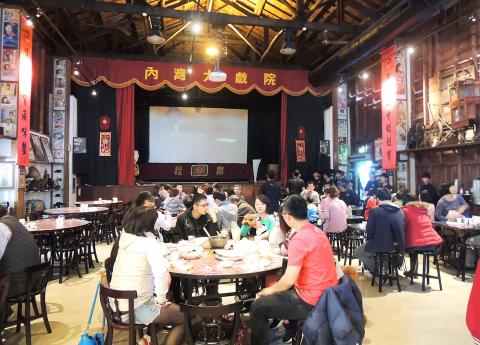
Photo: Enru Lin, Taipei Times
To go with the film, Neiwan Theater offers about 50 hot dishes created by the local population. Neiwan is a former coal-mining village that today is home mainly to the Hakka people, whose cuisine can be identified by some touchstone adjectives: salty, aromatic, heavy on the oil, economical, creative and sparked up by pickles.
Perfection (十全十美, NT$250) is most of the above. It’s an everyday version of Buddha Jumps over the Wall, a Spring Festival dish that often includes top-shelf animal products like abalone and shark fin, and vegetables like ginseng and Japanese flower mushroom. Neiwan Theater’s humbler variant uses bamboo, taro, vermicelli noodles, bits of cured ham and pork tendon, which looks to be the priciest ingredient. Though without grandeur, each component appears to have been prepared the right way — slowly and separately — so that they are equally soft and redolent with oil. The broth is as saltily rich as the shark-fin version, and Perfection still feels like a feast dish.
Neiwan Theater is famous for its betel nut flowers (檳榔花), a NT$150 dish made with the creamy white tufts growing below the leaves of a betel nut tree. These flowers are crispy and pretty palatable, with a flavor like bamboo. They are stir-fried with shaved carrots, celery, onions and some kind of mushroom, served in a hot heap glazed with a thin and delicately saline layer of oil.
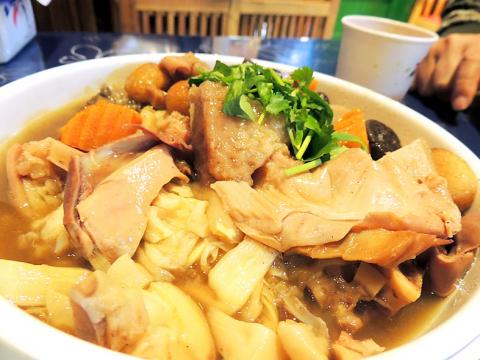
Photo: Enru Lin, Taipei Times
There is an army of young servers, notably all boys under 20, who form a line outside the kitchen, taking turns collecting a dish and dispatching it in a tidy flurry of industry. This means that with each dish, you meet a new server, who leaves as quickly as he arrives.
The strangest delivery was Egg Explosion (炸蛋開花, NT$150), which are fried eggs, dressed with chili sauce and served in slices like a pizza. The best was chicken soup with mesona (仙草雞湯, NT$150), which came last. This is roughly a quarter of wild chicken stewed with a handful of goji berries and dried mesona — a small thing that imparts a sweet minty freshness and transforms the broth from good to great.
Neiwan Theater also serves most of the familiar Hakka dishes such as salted pork (客家鹹豬肉, NT$150), oiled chicken (客家油雞腿, NT$200) and prawns steamed in a bamboo case (竹筒蝦, NT$200). Classic Hakka ingredients — available to buy at the street market outside the theater — make repeat occurrences on the menu. There’s a lot of white ginger lily, a fragrant flower with a slight cinnamon aftertaste, and some funky preserved vegetables that make an appearance in eggs, soup and meats.
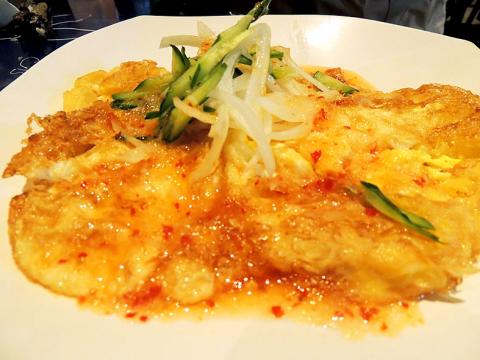
Photo: Enru Lin, Taipei Times
These preparations are not the most exquisite or ingenious that Hakka cuisine has to offer, but they are better than popcorn. With the reel going, meals here can stretch to three hours or more.
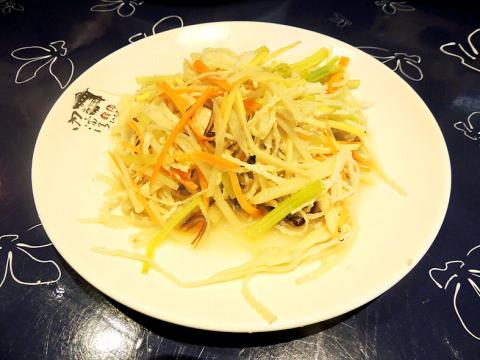
Photo: Enru Lin, Taipei Times

Many people noticed the flood of pro-China propaganda across a number of venues in recent weeks that looks like a coordinated assault on US Taiwan policy. It does look like an effort intended to influence the US before the meeting between US President Donald Trump and Chinese dictator Xi Jinping (習近平) over the weekend. Jennifer Kavanagh’s piece in the New York Times in September appears to be the opening strike of the current campaign. She followed up last week in the Lowy Interpreter, blaming the US for causing the PRC to escalate in the Philippines and Taiwan, saying that as

This year’s Miss Universe in Thailand has been marred by ugly drama, with allegations of an insult to a beauty queen’s intellect, a walkout by pageant contestants and a tearful tantrum by the host. More than 120 women from across the world have gathered in Thailand, vying to be crowned Miss Universe in a contest considered one of the “big four” of global beauty pageants. But the runup has been dominated by the off-stage antics of the coiffed contestants and their Thai hosts, escalating into a feminist firestorm drawing the attention of Mexico’s president. On Tuesday, Mexican delegate Fatima Bosch staged a

Taiwan can often feel woefully behind on global trends, from fashion to food, and influences can sometimes feel like the last on the metaphorical bandwagon. In the West, suddenly every burger is being smashed and honey has become “hot” and we’re all drinking orange wine. But it took a good while for a smash burger in Taipei to come across my radar. For the uninitiated, a smash burger is, well, a normal burger patty but smashed flat. Originally, I didn’t understand. Surely the best part of a burger is the thick patty with all the juiciness of the beef, the
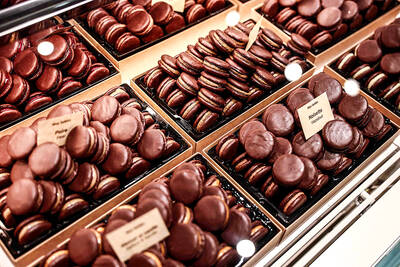
Would you eat lab-grown chocolate? I requested a sample from California Cultured, a Sacramento-based company. Its chocolate, not yet commercially available, is made with techniques that have previously been used to synthesize other bioactive products like certain plant-derived pharmaceuticals for commercial sale. A few days later, it arrives. The morsel, barely bigger than a coffee bean, is supposed to be the flavor equivalent of a 70 percent to 80 percent dark chocolate. I tear open its sealed packet and a chocolatey aroma escapes — so far, so good. I pop it in my mouth. Slightly waxy and distinctly bitter, it boasts those bright,